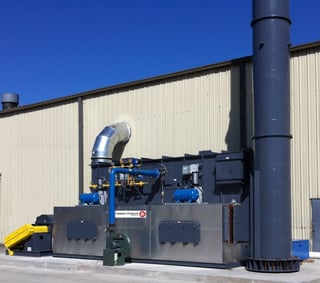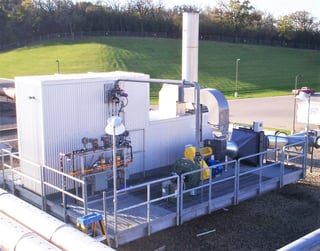| Volatile Organic Compounds (VOCs) and odors are natural by-products of many chemical manufacturing processes. The manufacturing of powdered and liquid flavorings & fragrances involves production phases where VOCs and odors can escape into the ambient air. Recapture of the VOCs is important in the prevention of air pollution and smog. Smog is formed when VOCs react with nitrogen oxides (NOx) in the presence of sunlight. The reaction forms ground level ozone, airborne particulates, and some other pollution. |  |
Ozone has been selected as the standard to measure ground level pollution, a precursor under EPA’s criteria pollutant program. Areas of the country that have ozone readings above EPA guidelines are ruled nonattainment areas and have stricter regulations for VOC, CO, and NOx emissions. This proves that although the compounds that create offensive odors may not be present in sufficient concentrations to present a health risk, they can diminish the quality of life for the community surrounding the manufacturing process.
CPI is taking a technical leadership position offering multiple oxidation solutions to eliminate VOCs emitted from chemical manufacturing. Oxidation of VOCs and other air pollutants works by simply oxidizing the air pollutants with oxygen and heat. In this environment the VOCs are converted to harmless inert byproducts like CO2, water vapor (H2O), and usable heat. These harmless by-products are released to the atmosphere or used within primary or secondary energy recovery techniques to further lower the operational costs.
Both catalytic oxidizers and thermal oxidizers are appropriate control technologies applicable to VOC and odor emissions from flavoring processes. However, regenerative thermal oxidizers (RTOs) are recognized as the most effective and cost-efficient way to destroy both VOCs and odor causing compounds from these processes. In the flavoring and fragrance industries, most processes are batch in nature and the organic and inorganic makeup may differ widely batch to batch or product to product.
Typically, sellable product in the dry flavoring process is captured by a cyclone. The majority of the solids is captured in the cyclone, but there is some particulate that escapes the cyclone and should be captured with a baghouse particulate dust collection system. These control devices do a good job capturing the product and eliminating particulate matter from escaping the process. If the process contains VOCs and requires an oxidizer, the baghouse also protects the oxidizer from particulate carryover. Problems occur when there is bag breakage and particulate matter is not captured. This creates a concern with oxidizers where particulate and/or fouling can reduce the destruction efficiency of the unit and increase operational costs. Catalytic oxidizers are very sensitive to particulate carryover. Alternatively, Regenerative Thermal Oxidizers (RTOs) can handle small amounts of particulate with VOC destruction remaining constant throughout the life of the unit. Regenerative Thermal Oxidizers also provide lower capital costs and higher thermal efficiencies resulting in lower fuel costs.
Regenerative Thermal Oxidizers (RTOs)

Each Regenerative Thermal Oxidizer (RTO) system incorporates specialized ceramic media in the regenerator (heat transfer bed) to allow thermal efficiencies up to 97%. RTOs operate by preheating the process air as it passes upward through the first ceramic heat exchange media. This pre-heated air then exits the heat exchange media and enters a combustion chamber where it is heated to the setpoint temperature and oxidization of the VOC’s is completed. Hot, clean air is then passed downward through the second ceramic heat exchange media bed where it is cooled. This regeneration of the ceramic heat exchange media usually takes place in 3 minute cycles, meaning that the flow through the oxidizer changes direction every 3 minutes. This regeneration of the heat exchanger allows for much higher thermal efficiencies than traditional recuperative style heat exchangers.
The overall VOC destruction of the RTO system are really dependent on 3 items:
- The entrained volume – The amount of air that is reversed out of the system during a valve change.
- The amount of air bypassed – During the changing of the valves air is allowed to pass directly to stack.
- Sealing of the valves – This is the quality of seal generated at each switch.
The CPI TRITON RTO design minimizes the entrained volumes, making this volume of air very small. The CPI TRITON takes advantage of unique valve technology to switch the valve positions in less than one second and provide a reliable, metal to metal seal (no gasketing) that is designed to operate the life span of the RTO delivering greater than 98% destruction rate efficiency and provide exceptional performance and reliability.
Examples of Regenerative Thermal Oxidizers (RTOs) used by manufacturers of flavoring and fragrance for the abatement of Volatile Organic Compounds (VOCs) and odors:
Five (5) ingredient spray dryers with 10,000 SCFM of process exhaust
- Customer needed to control the VOC emissions and odors generated from four existing spray dryers with the capacity to add a fifth dryer to their operation.
- The exhaust streams generated from the five ingredient spray dryers were ducted to a new
10,000 scfm TRITON-10.95 Regenerative Thermal Oxidizer (RTO) destroying the incoming VOCs to 98% or to a lower limit of 30 ppm as C₁ at a thermal rate efficiency (TRE) of 95%.
- CPI provided a complete turn key installation on a concrete foundation outside the facility, including design and supply of the Regenerative Thermal Oxidizer (RTO), electrical work, natural gas supply and compressed air piping, stainless steel ductwork and system startup.
- CPI provided on-site supervision to ensure coordination with the third-party sub-contractors and was able to complete a good portion of the installation activities before the new unit arrived on site. This approach guaranteed that entire system was installed correctly, and the facility was back up and producing product with minimal downtime.
Two (2) ingredient spray dryers with 8,000 SCFM process exhaust.
- Customer expanding their production capacity with the installation of a second spray dryer. As part of this expansion the customer needed to control the VOC emissions and odors from the new and the existing spray dryers.
- A new 8,000 scfm TRITON-8.95 Regenerative Thermal Oxidizer (RTO) was designed to destroy the incoming VOC’s from the two spray dryers to 98% or to a lower limit of 30 ppm as C₁ at a thermal rate efficiency (TRE) of 95%.
- CPI provided engineering, design and supply of the TRITON-Series Regenerative Thermal Oxidizer(RTO).
- CPI acted as a liaison with general construction contractor hired by the customer to provide both on-site and in-office support to insure compliance with the provided bid specifications.
- Rigging and assembly of the RTO and related equipment onto concrete foundations inside the facility were provided by the general construction contractor.
Catalytic treatment of VOCs and other air pollutants works by utilizing a specially designed precious metal catalyst where VOCs proceed through the combustion reaction and are converted to CO2, water vapor (H2O), and usable heat. Catalytic systems typically utilize primary heat recovery. The heat exchanger utilizes the clean exhaust gases post catalyst to preheat the process gases entering the system.

In the flavoring industry it is typical to have some small amount of organic particulate carry over to the oxidizer. The CPI VECTOR Catalytic Oxidizer utilizes a unique condensate evaporation/particulate bake off section in conjunction with a burner system to remove the particulate before entry into the catalyst section of the oxidizer. The process emissions are directed into the burner section that is designed to provide guidance of the process air directly through the burner flame. The process gas is then immediately forced through the condensate evaporation/particulate bake off section before traveling to the catalyst bed. The design of this system incorporates direct flame impingement on to the condensate evaporation/particulate bake off section and systematically breaks down the stream helping to volatilize any condensate remaining and keeps particulate to an absolute minimum.
As mentioned above, an integral part of the VECTOR Catalytic Oxidizer’s performance is the high velocity mixing chamber at the burner, which creates the turbulence needed to ensure proper mixing of the air stream. By designing for the highest mixing, the system can deliver the highest temperature uniformity before the catalyst bed. Temperature uniformity ensures that 100% of the catalyst is efficiently oxidizing the VOC’s. No other manufacturer of catalytic oxidizers can incorporate the advantages of temperature uniformity before the catalyst bed and controlled thermal expansion in a user-friendly system. The CPI VECTOR Catalytic Oxidizer provides a minimum 99% VOC destruction of the emissions from the process.
Since 1969 CPI has been providing industry leading flavoring and fragrance companies with solutions to their air pollution control needs.
Today, CPI partners with its customers as a trusted resource in resolving the most complex air pollution and energy conservation problems. We provide our customers with innovative and cost-conscious solutions to their most complex VOC, NOx, and Odor pollution challenges. Our equipment is also at work meeting energy conservation strategies and minimizing greenhouse gas (GHG) emissions.
Notes on Scott’s experience:
Scott Harmsen has been in the air pollution control industry for over 22 years and is the COO of Catalytic Products International (CPI). Scott received a BS in Chemical Engineering from Michigan Technological University and has advanced through successively increasing roles of engineering and operations responsibility in his career. In addition to leading the Operations side of CPI, Scott also directly manages the Application Engineering team. Scott has been involved in all aspects of the design, build, installation, and service of air pollution control solutions worldwide.








